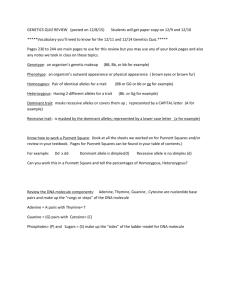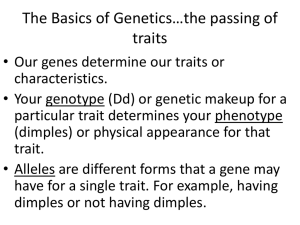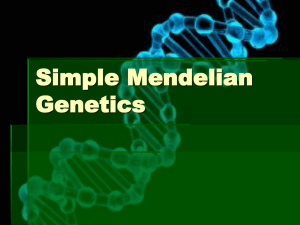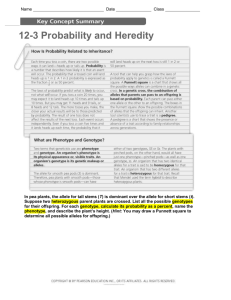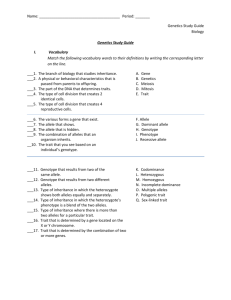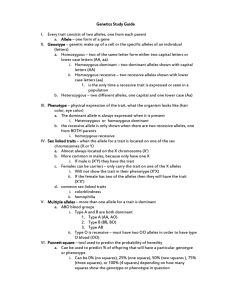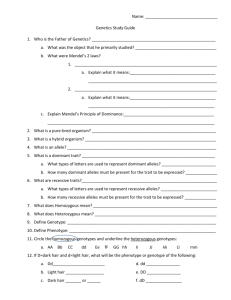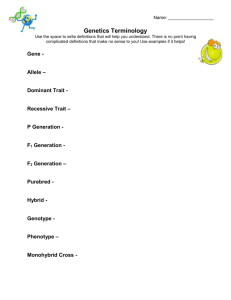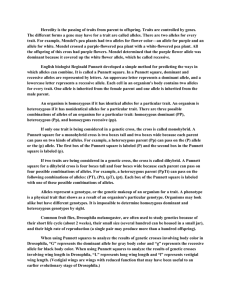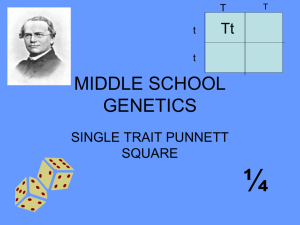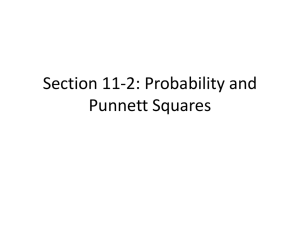Goal #2: Punnett Squares
advertisement
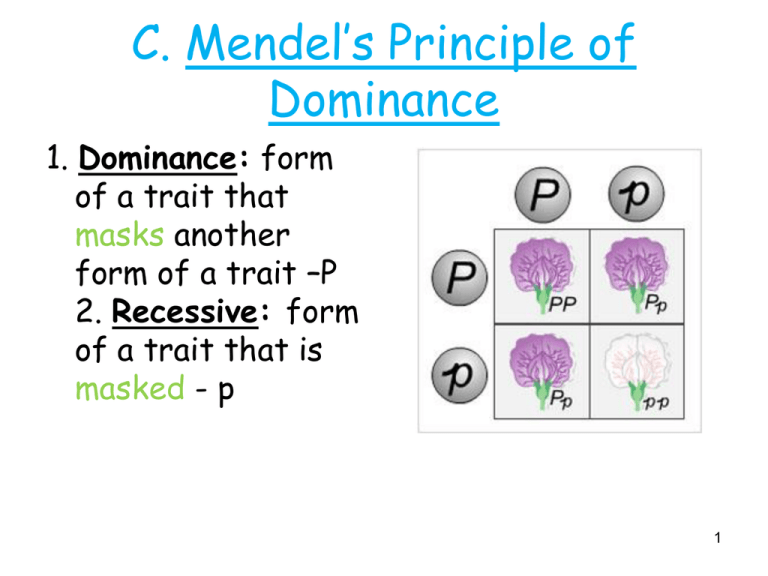
C. Mendel’s Principle of Dominance 1. Dominance: form of a trait that masks another form of a trait –P 2. Recessive: form of a trait that is masked - p 1 III. Probability: science that helps determine the chance that something will take place. a. multiple trials provide more accurate results. b. Scientific research is based on accurate, repeatable results. 2 Goal #2: Punnett Squares IV. Punnett square: A diagram that shows how alleles of a gene from two parents combine to form offspring – used to predict results of heredity Alleles A. Dominant allele 1. Use a capital letter 2. Ex: B= Brown eyes B. Recessive allele 1. Use lower case letter 2. Ex: b= blue eyes When an individual has different amounts of melanin in each of their irises, their eyes are different colors. Heterochromia iridium (the scientific name for two different color eyes in the same individual) is relatively rare in humans but common in some animals, such as horses, cats, and certain species of dogs. A variation on the condition is heterochromia iridis, in which an individual has a variety of colors within one iris. Heterochromia iridium is thought to result from an alteration to one of the genes that controls eye color. This can be an inherited trait, although trauma and certain medications may result in increased or decreased pigmentation in one of the irises. Certain medical syndromes, such as Waardenburg syndrome, may also cause someone to have two different colored eyes. C. Genotype: genetic make-up of an organism 1. cells have at least 2 alleles for every trait 2. Homozygous- organism with two alleles for a characteristic that are the same - purebreds - can be dominant (TT) or recessive (tt) 3. Heterozygous- organism with two different alleles for a characteristic (Tt) – hybrids D. Phenotype: physical appearance of the trait shown by the particular genotype. – Qualitative characteristic – Ex: tall plant, blue eyes, blond hair, etc. V. Law of Segregation pairs of alleles separate, or segregate, during meiosis (the formation of gametes) • means that a gamete only receives one half of the pair of alleles of one gene VI. Constructing Monohybrid Crosses • 3 types 1. Homozygous x Homozygous (AA x AA, AA x aa, or aa x aa) 2. Heterozygous x Homozygous (Aa x AA or Aa x aa) 3. Heterozygous x Heterozygous (Aa x Aa) Genetics problem: Black is the dominant allele of the trait for color of hair on Labrador retrievers. Yellow is the recessive allele. If a purebred black lab is bred with a purebred yellow lab, what will the genotypes and phenotypes of the 1st generation of offspring be? Problem Set-up: B= Black b= Yellow P1: BB x bb F1 Genotype: F1 Phenotype: F1 ratio: Practice Now set up a cross (using the correct setup) in your notes crossing the F1 and record the results of the F2 genotypes and phenotypes. • Trade with partner next to you and check! • Ask questions if you are unsure • You will have to do this on the test! VII. Testcrosses crossing an unknown individual with a homozygous recessive individual to find the unknown. A. This is a little like “guess and check” in math terms. Short hair is dominant over long hair in monkeys. Cross a homozygous short hair monkey with a heterozygous monkey. B#1: How are dimples inherited? C#2: Punnett Squares Construct a manual on how to use Punnett squares. Include a labeled diagram of a Punnett square, step-by-step directions on how to use one, why they are so useful in genetics, and an example of one. Imagine you came upon a tall pea plant similar to those Mendel used in his experiments. How could you determine the plant’s genotype with respect to height? Draw 2 Punnett squares to show your answer. Complete worksheets “Bikini Bottom Genetics” & “Bikini Bottom Genetics 2” – available on my website. Each worksheet worth 5 points. 11-2 Section Assessment – must be in complete sentences 10 5 10 5
